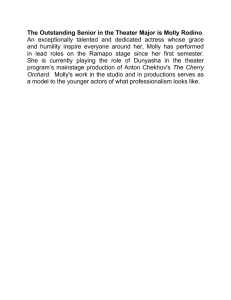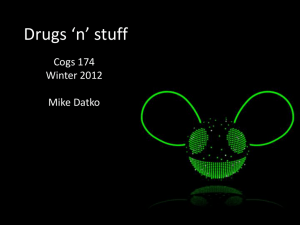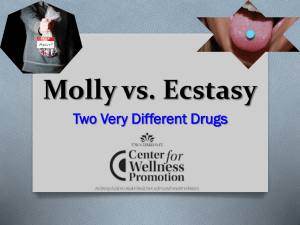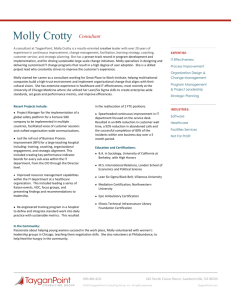Fall 2013 Vol. 62
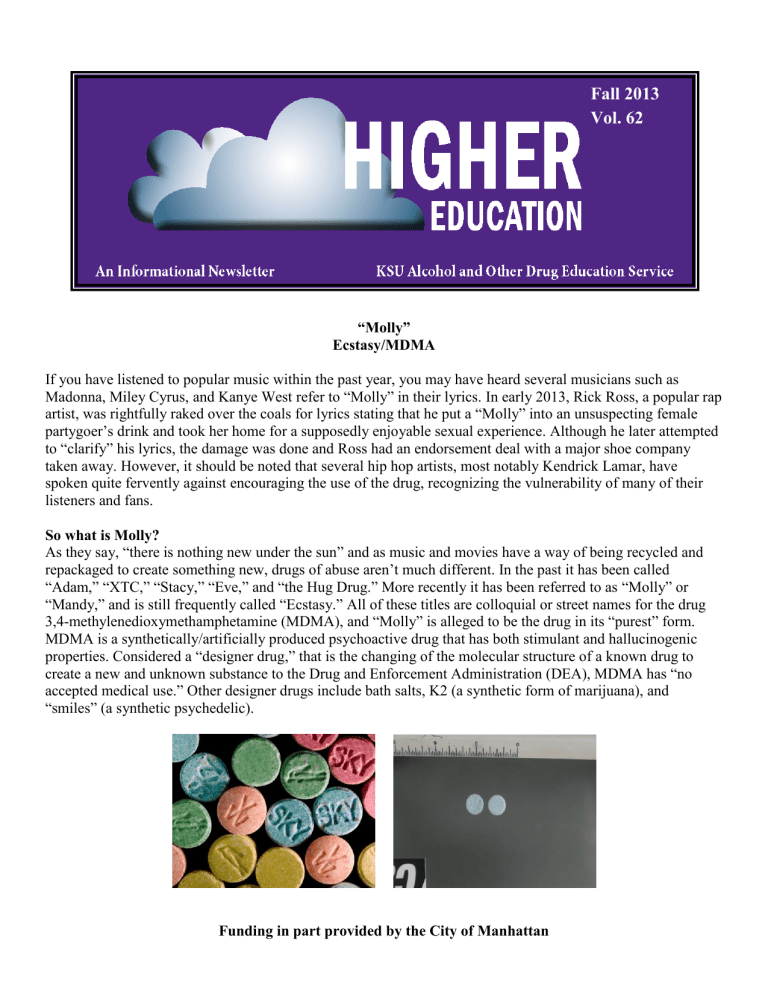
Fall 2013
Vol. 62
“Molly”
Ecstasy/MDMA
If you have listened to popular music within the past year, you may have heard several musicians such as
Madonna, Miley Cyrus, and Kanye West refer to “Molly” in their lyrics. In early 2013, Rick Ross, a popular rap artist, was rightfully raked over the coals for lyrics stating that he put a “Molly” into an unsuspecting female partygoer’s drink and took her home for a supposedly enjoyable sexual experience. Although he later attempted to “clarify” his lyrics, the damage was done and Ross had an endorsement deal with a major shoe company taken away. However, it should be noted that several hip hop artists, most notably Kendrick Lamar, have spoken quite fervently against encouraging the use of the drug, recognizing the vulnerability of many of their listeners and fans.
So what is Molly?
As they say, “there is nothing new under the sun” and as music and movies have a way of being recycled and repackaged to create something new, drugs of abuse aren’t much different. In the past it has been called
“Adam,” “XTC,” “Stacy,” “Eve,” and “the Hug Drug.” More recently it has been referred to as “Molly” or
“Mandy,” and is still frequently called “Ecstasy.” All of these titles are colloquial or street names for the drug
3,4-methylenedioxymethamphetamine (MDMA), and “Molly” is alleged to be the drug in its “purest” form.
MDMA is a synthetically/artificially produced psychoactive drug that has both stimulant and hallucinogenic properties. Considered a “designer drug,” that is the changing of the molecular structure of a known drug to create a new and unknown substance to the Drug and Enforcement Administration (DEA), MDMA has “no accepted medical use.” Other designer drugs include bath salts, K2 (a synthetic form of marijuana), and
“smiles” (a synthetic psychedelic).
Funding in part provided by the City of Manhattan
MDMA most commonly appears as a powder or a pill. In pill form, it is often designed to make it look similar to other legitimate medications. Molly is typically found in a crystalline/powder form, contributing to the myth that it is somehow a more “pure” substance. Unlike marijuana or tobacco, which come from plants, MDMA is completely man-made. Other chemicals like caffeine, amphetamines, dextromethorphan (found in some cough syrups), PCP, or cocaine, are sometimes included in, or replace MDMA in Ecstasy or Molly tablets. These additives tend to be regionally specific and vary from country to country. As a result, it is difficult or even impossible to know exactly what has been put in them or if it has been replaced by another substance altogether.
In 2003, several teenage deaths in Norway were attributed to dealers using a substance known as paramethoxymethamphetamine (PMA) , a hallucinogenic amphetamine, and labeling it as MDMA. And, in a
September of 2013 report published by ABC News Health, four teenage/ young adult deaths were linked to a
“bad batch” of Molly being distributed at a music festival in New York City. This speaks to the motivations of many of the illicit drug creators, which is to produce the cheapest product possible to increase their profits with little to no regard for the safety or well-being of those individuals who might use it.
History of MDMA/Molly
MDMA was first discovered by Merck, a German pharmaceutical company, in the early 20 th
century. It was hoped that the substance would be used as a way of staunching abnormal bleeding in medical patients. Some less reputable sources have suggested that the United States military experimented with MDMA in the 1950s in hopes that it could be used as an interrogation tool (truth serum) or a way to incite hysteria in large groups of people.
It is believed that MDMA was first used in the United States of America for recreational and psychotherapeutic purposes in the 1970s. Some psychotherapists actually gave their patients MDMA in counseling sessions because it was believed to enhance emotional connection and communication. In the late 1980s and early 1990s,
MDMA grew in popularity in pseudo-religious practices and the club scene frequently referred to as “raves.” As recently as 2011, researchers published a study suggesting that MDMA could be used to treat Posttraumatic
Stress Disorder (PTSD) in survivors of sexual assault and in military veterans. This study was met with some resistance due to concerns about safety and the methods used for studying its effectiveness.
How Does Molly Impact the User?
As previously stated, “Molly” is a stimulant and a hallucinogenic drug. People use it by either swallowing a pill or snorting it in its powdered form. “Molly” usually makes its way to the brain through the bloodstream anywhere between 15 minutes to an hour after first ingesting the substance. The peak experience usually occurs after about an hour and a half to two hours of when the substance is ingested. When the high levels off, it can last anywhere from two to three hours. People will sometimes take one large dose during the course of the time they are using, and it is not unusual for someone to take multiple doses or “bumping” over the course of an evening.
The drug effects tend to largely be idiosyncratic or vary from individual to individual; however, there are some common features across user experiences. It impacts the chemicals in the brain responsible for mood, emotion, and pain: dopamine and serotonin. The most commonly reported effects are feelings of increased energy, selfconfidence, and euphoria/immense joy. Many report a heightened sense of connectedness with others and a desire to be closer or intimate with people, hence the slang term “hug drug.” Users also have psychedelic experiences like altered perceptions, and de-realization or depersonalization. This means that the individual either views the world as being unreal (de-realization); or, one might feel as though one is not truly connected with the body or the self (depersonalization). In some instances, people report experiencing synesthesia, a state where multiple senses are connected, so the individual might hear what they see, or feel what they hear.
According to the National Institute of Drug Abuse (NIDA), whereas many people who use MDMA may have the desired effects, some individuals may begin having negative experiences right from the start. They could experience nervousness or paranoia, they might begin sweating or having chills, and/or they could feel dizzy or faint. The individual could also experience muscular tension, bruxism (clenching or grinding of the teeth), nausea, blurred vision, and increased heart rate or blood pressure. After the high has ended, the person can experience a number of changes. There tend to periods of confusion, disrupted or poor sleep, depression, anxiety, and paranoia.
It is also common for the user to experience dehydration and exhaustion because MDMA interferes with the body’s ability to regulate temperature. Because raves tend to be closed in environments with lots of people in close proximity, it is not unusual for people to suffer from a heat stroke or hyperthermia. People can also sometimes suffer seizures. Although the instances are rare, individuals have died at large gatherings because of a combination of heat stroke and the use of MDMA.
Another concern about the use of Molly is that it is linked to unwanted sexual encounters or risky sexual behaviors. Thus, it increases the risk for sexual assault, unwanted pregnancies, and the risk for contracting sexually transmitted diseases.
Prolonged use can have a number of adverse effects on the user. Because MDMA has an impact on serotonin and dopamine levels, the drug can impact normal experiences of emotion, mood, and pain. It can also cause damage to the individual’s memory and ability to appropriately process/regulate emotions. Individuals who repeatedly use tend to have frequent bouts of depression or anxiety when they are no longer on the substance.
However, researchers have also found that if the individual is able to abstain, some of these difficulties can be reversed, but it often takes a number of years.
Who Uses Molly?
According to the Global Drug Survey (a survey that examines drug used around the world among more than
20,000 participants) published in 2013, after alcohol and marijuana, MDMA is the most commonly abused drug by individuals over the age of 12. In fact, according to this same survey, users report that Molly/MDMA is the drug that has the highest level of pleasurable experience associated with it as measured by their pleasure index.
It is a drug that is used primarily amongst teens involved in the club scene; however, more recently individuals in their early to mid-twenties are using Molly. One has to wonder what, if any influence popular music might be having on these trends.
Be Cautious, Be Smart
Because MDMA is an artificial substance and serves no actual medical purpose, it can be quite dangerous to users. As much as some might suggest that Molly is “pure” and therefore “safe,” a very dangerous game is being played if someone chooses to use. If you or anyone needs Molly or any other substance to have a pleasurable experience and/or enjoy life, it might be an indication that there is a serious problem and you are urged to seek out help and support.
Sources: http://www.drugabuse.gov/ http://teens.drugabuse.gov/ http://www.justice.gov/dea/pr/multimedia-library/publications/drug_of_abuse.pdf
Bernschneider-Reif S, Oxler F, Freudenmann RW (2006). The Origin of MDMA ("Ecstasy")--Separating the
Facts From the Myths". Pharmazie 61 (11): 966–972. http://abcnews.go.com/Health/club-drug-molly-eyed-deaths/story?id=20180492
Alcohol Health and World Research 14 (2) 87, 1990 http://www.globaldrugsurvey.com
